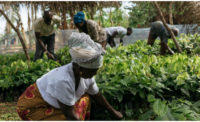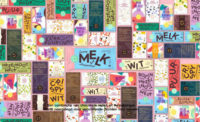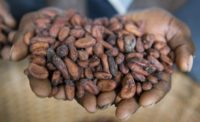Though darkness still blanketed the surrounding fields, trucks rumbled up the red clay road, appearing in a flurry of headlights and honking horns.
Shouting signaled the start of the workday at Finca El Cacao, a 2,500-hectare cocoa plantation in southeast Nicaragua owned and operated by Alfred Ritter GmbH & Co. KG. Workers from surrounding villages had arrived just after 5 a.m. to split and deseed thousands of cocoa pods cut from their trees the day before.
It’s now a common scene at the finca (rural estate), but in 2012, the area looked much different, says Andreas Ronken, ceo of the Waldenbuch, Germany-based maker of the square Ritter Sport chocolate bars.
“When we came here, the infrastructure was nonexistent,” he said. “We had more than 70 or 80 kilometers of streets we had to build. We had to build bridges.”
There was no electricity or running water on the compound, initially accessible only by horse. Now the site employs 350 people and features a kitchen and eating area for workers, furnished cabins with water and electricity for visitors, a medical center, and facilities for quality testing and equipment storage.
The six-year journey has been a long one, but it’s paid off: Ritter harvested its first cocoa crop in 2017, presenting new possibilities for the company’s product portfolio and pushing it closer to achieving its sustainability goals. Ultimately, Ritter hopes to pull 20-25 percent of its cocoa mass needs from the finca once it reaches full capacity in 2025.
“It’s a very important role cacao plays for our company,” Ronken said. “It’s a really big investment. It’s a really big change in knowledge. Before, we didn’t have the competencies to grow cacao. (But), we went there.”
And now Ritter is ready to show it to the world. In February, the company brought journalists from the German press corps and Candy Industry to Nicaragua to highlight Ritter’s ties to the Central American country and illustrate its accomplishments there.
Ritter’s origins in Nicaragua
Ritter’s connection to Nicaragua goes back further than 2012. In 1990 — just after the civil war between the Contras and Sandinista forces ended — Marli Hoppe-Ritter and Alfred T. Ritter turned to Nicaragua.
“Being a small chocolate producer, they chose Nicaragua because it was a relatively small country and they thought the impact there can be successful,” Ronken said.
That same year, under what would become the Cacao-Nica program, Ritter began sourcing cocoa from 170 farmers. Even with Finca El Cacao, the company sources — and will continue to source — from 3,500 small farmers working through more than 20 cooperatives.
The Cacao-Nica program aims to enhance both the quality of cocoa and farmers’ lives through vocational training, buying at higher-than-market prices and use of an agroforestry system designed to bolster yields and incomes.
In 2008, Ritter built a drying and buying station in northwest Nicaragua near hilly, breezy Matagalpa. Serving as the primary contact point for many of Ritter’s partner farmer cooperatives, the station receives cocoa beans for sorting and quality testing. They’re then packed for the 25-day trip to Germany for roasting.
Ritter’s strategies have worked. Last year, Ritter’s Matagalpa station received 850 to 1,000 metric tons of cocoa. That total is expected to reach up to 1,200 tons this year, said Jaume Martorell Mir, former head of purchasing at Ritter Nicaragua S.A.
But that’s not all. In 2016, the International Cocoa Organization officially listed Nicaragua as one of 23 countries of origin for fine cocoa. It’s also one of nine countries whose total cocoa exports are classified as fine flavored cocoa, joining Bolivia, Costa Rica, Dominica, Granada, Madagascar, Mexico, St. Lucia, Trinidad and Tobago and Venezuela.
Finca El Cacao
We drove for six hours on NIC-7— a two-lane road winding through villages and across the Nicaraguan countryside — before reaching the unnamed, red-clay access road leading to Finca El Cacao.
For nearly 40 kilometers Ritter’s vehicles bounced through mud and dodged trucks carrying materials to and from construction sites. When we finally arrived, guards opened gates to reveal a lush, green landscape and neat rows of cacao trees. It looked as if the finca had always been there.
But that’s certainly not the case. Ronken said much consideration went into selecting the finca’s location, particularly soil quality, the levelness of the ground and sources of stone for infrastructure.
“This was a long process,” he said. “If you go (into) agriculture, you have to look for a lot of things. The most important thing is you have to have water.”
There’s plenty of it in the rainforest climate of southeast Nicaragua. Plantation Manager Volker Schuckert said the finca had seen 200 milliliters of rain by late February, which is typically in the dry season. Though ideal for growing cacao, the rain wasn’t conducive to infrastructure improvements.
“One side smiles while the other side cries,” Schuckert said, bisecting his face with his hand.
The Río Kama also snakes through the plantation, collecting runoff and serving as a water source. The café-colored river, swollen when the group toured it by boat, also supports Ritter’s agroforestry method, drawing monkeys, iguanas, toucans and other wildlife.
The seamless blending between the finca’s natural and cultivated areas is a hallmark of Ritter’s agroforestry system. Roughly 1,000 hectares of Finca El Cacao will remain natural, while 1,200 will be planted with cacao trees and a mix of banana, guava and mahogany trees to provide shade and other fruit. About 900 hectares have been planted so far.
“The plantation’s diverse range of plants creates a healthy microclimate, and thus sustainable production, while requiring only minimal expenditures on pesticides,” said Hans Wiberg, project manager R&D - raw materials scouting and cultivation, in Ritter’s 2016 Progress and Sustainability Report.
Location is only part of the equation, however. Ritter plants a dozen Trinitario cocoa varieties originating from the area, yielding beans with a mild, fruity flavor. Each sapling is grafted by hand to enhance flavor and increase productivity.
So far, Ritter has about 1.3 million trees in production, with another 120,000 maturing in one of three nurseries on the plantation. At five years old, the finca’s most mature trees produce a rainbow of pods, and their contents are proving to be exactly what Ritter hoped for.
“It’s exceeding expectations,” Ronken said. “We are very pleased with the quality.”
Once harvested, the pods are brought to Ritter’s prototype deseeding machine designed by German engineers. Workers feed cocoa pods into the prototype, which slices them lengthwise and sends them into a rotating drum that gently knocks out the pulp-covered seeds. Pod fragments are plucked from the mass of pulp and beans, which is collected for drying and fermenting. Pod fragments are composted to make use of their potassium levels.
“It would be a serious waste not to bring it back into the cycle,” Schuckert said.
The finca uses the second or third version of the prototype, the components of which were built in Germany and shipped to Nicaragua. Ronken estimates the machine, which processes roughly 20,000 pods an hour, is about 80 percent complete.
In addition to increasing efficiency and improving safety — pods are usually opened by hand with machetes — the machine serves as a cultural bridge between Germany and Nicaragua, Ronken said.
“We don’t want to be just the guys who get the cacao out of Nicaragua and don’t bring anything,” he said. “We want to bring something. Especially in Germany, in the region where Porsche is, Mercedes is and other small companies (including Ritter) are, we are very good in mechanization and automation, and we wanted to bring that.”
The full machine is expected to arrive at the end of 2019.
‘A new standard’
Ritter has a laser focus on sustainability, particularly when it comes to cocoa. The company, having received accreditation through the Centre for Sustainable Corporate Leadership (ZNU), aimed to use only certified sustainable cocoa by 2025. In January, Ritter announced it had achieved that goal seven years earlier than expected.
Ronken said steady progress at Finca El Cacao, along with the Cacao-Nica program and strong partnerships with Cémoi and Fuchs and Hoffman in the Ivory Coast, expedited the process.
“It’s the only way to go. It’s not the question of go or not go — it’s only a question of time,” he said. “100 percent-certified cocoa is a must-have. It’s a new standard. It was clear for us we have to go there anyhow, and it’s the right way to go. We just weren’t sure about the timing.”
Ritter’s efforts also earned the company a German Sustainability Award in the mid-sized company category. Though pleased with the recognition, Ronken said Ritter has no intention of stopping there.
“For us, the journey is not to an end. It’s a very important milestone,” he said. “We want to go further. We want to go to direct sourcing. We want to make the whole value chain transparent.”
That includes treatment of the finca’s employees. While ZNU requires above-average pay for workers, Ritter also takes education into account.
Darwin Navarete, the 25-year-old manager of one of the plantation’s nine growing zones, worked up to a leadership role from an internship. While standing among his cocoa trees in late-afternoon drizzle, Navarete said he appreciates the opportunity to “learn new things, operate machinery and direct personnel.”
In addition to honing employees’ skills and fostering understanding of the cacao growing process, the company also offers education and culture in the evenings. More specifically, Ritter has plans to build a cultural center — Casa de los Tres Mundos — designed to celebrate local heritage.
To Ronken, these initiatives are requirements, not fringe benefits.
“If you want to enjoy cacao in the long-term — and we as family think in generations — we have to do something for the guys who do the farming,” Ronken said. “Otherwise in 50 years maybe nobody (will want) to do it.”




















